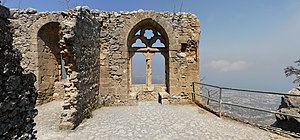St. Hilarion (Castle)
| St. Hilarion Castle | ||
|---|---|---|
|
View of the fortress 2013 |
||
| Alternative name (s): | Castle of 1000 chambers | |
| Castle type : | Höhenburg, summit location | |
| Conservation status: | ruin | |
| Place: | Girne | |
| Geographical location | 35 ° 18 '43.7 " N , 33 ° 16' 51.9" E | |
|
|
||
The castle St. Hilarion , popularly "Castle of 1000 chambers", is the ruin of a hilltop castle in Northern Cyprus not far from Kyrenia (Girne) on a rocky knoll and dominates the pass road from Kyrenia to Nicosia . It is the best-preserved castle ruin of the three former fortresses - next to Kantara and Buffavento - in the Pentadaktylos .
history
A 9/10 The monastery built on the mountain in the 18th century was named after the hermit St. Hilarion, a hermit from the 6th century who spent the last years of his life in a cave in Pentadactylos. It was probably integrated into the fortress around 1100. The church, which is now in ruins, can be assigned to the Byzantine monastery and dates from around 10/11. Century. On behalf of Richard the Lionheart, Guido von Lusignan besieged the castle , which was considered impregnable, in 1191, only to hand it over to the Franks on the instructions of the governor Isaak Komemnos. The daughter of Isaac was then imprisoned in the castle by Guido von Lusignan.
Thirty years later, St. Hilarion was drawn into the dispute with the German Emperor Friedrich II : Johann von Ibelin , the guardian of the underage Frankish-Cypriot King Henri I , had the castle expanded. Because he feared hostile acts by Emperor Friedrich II, he brought his family to the castle in 1228. Supported by his crusader army, Friedrich managed to hand over the castle, but after the end of the crusade, Johann von Ibelin besieged the castle, which surrendered after the food supplies ran out.
After 1232 the Lusignans expanded the castle into their summer residence and it was given the name “Dieu d'Amour” - derived from the Greek “Didymoi” (twins) - referring to the two peaks of the upper castle. New towers were built at strategic points, which are characterized by the use of larger blocks, especially at the corners.
The castle also played an important role in the Genoese invasion of Cyprus in 1373 with the siege of Kyrenia by the Genoese , Peter I defended the castle. After the death of Peter I in 1369, his son Peter II came to power, but he was not recognized by the nobility. His uncle John of Antioch should now become king. Eleanor of Aragon , the widow of Peter I, and her entourage fought John, forcing him to retreat to St. Hilarion Castle. There he allegedly fell from the rock to their death for fear of betrayal of 300 of his Bulgarian bodyguards ; he himself was murdered in 1374 at Eleanor's instigation.
Around 1391 the fortress was expanded for the last time, but like many other castles in Cyprus it was razed by the Venetians at the beginning of the 16th century .
Appearance
The castle complex is divided into upper, lower and outer bailey. St. Hilarion had a total of three lines of defense on the east side. The other sides of the castle were adequately secured by a steep drop and did not have to be specially fortified. By the Kennel you enter the front castle , in the adjacent stables and a barracks for the soldiers a large cistern was. A gate secured with a drawbridge led to the lower castle with the monastery church . This was equipped with a large dome and belongs to the type of a so-called eight-pillar church . Next to it was a large hall, the former refectory . To the east is the Belvedere, a platform with a good view of the Pentadactylos and the coastal region, and the former royal apartments.
The lower and middle courtyards were used for economic purposes. The main castle housed the buildings of the royal family. Most of these buildings are of Byzantine origin.
The Prince Jean Tower sticks to a cliff high above the lower castle. The Bulgarians are said to have been pushed into the abyss from this tower.
The double fortified upper castle can be entered through a well-preserved archway . While the farm buildings are in the north, the king's chambers are in the west. The windows with side benches, decorated with richly decorated Gothic tracery , give an insight into the former splendor. You have a beautiful view to the west from the “Queen's Window”.
literature
- Astrid Feltes-Peter (arr.): Cyprus. Baedeker, Ostfildern 2001, ISBN 3-87504-419-3 .
Web links
- St. Hilarion Castle. On: dickemauern.de
- St. Hilarion Castle. On: cypnet.co.uk




